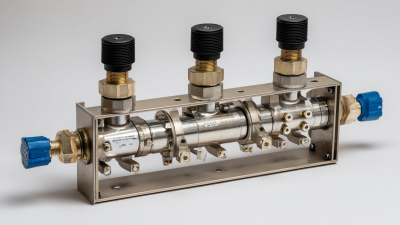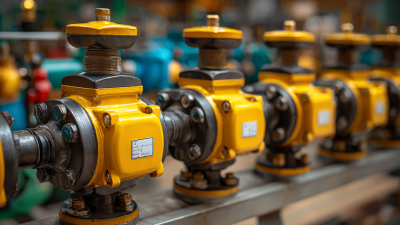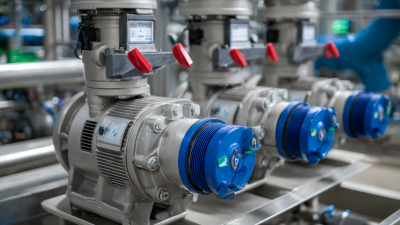7 Essential Benefits of Using High Pressure Ball Valves in Industrial Applications
In various industrial applications, the importance of efficient fluid control cannot be overstated, and one essential component that plays a pivotal role in this aspect is the high pressure ball valve. According to a report by
MarketsandMarkets, the global ball valve market is projected to reach USD 17.6 billion by 2025, driven largely by increased demand in the oil and gas, water and wastewater, and power generation sectors.
 High pressure ball valves are renowned for their durability, reliability, and ability to withstand extreme conditions, making them an optimal choice for handling high-pressure systems. Their design allows for minimal resistance, enhancing flow performance while ensuring tight sealing to prevent leaks.
As industries continue to evolve and expand their operations, understanding the critical benefits of high pressure ball valves becomes essential for maintaining efficiency and safety in fluid transport and management processes.
High pressure ball valves are renowned for their durability, reliability, and ability to withstand extreme conditions, making them an optimal choice for handling high-pressure systems. Their design allows for minimal resistance, enhancing flow performance while ensuring tight sealing to prevent leaks.
As industries continue to evolve and expand their operations, understanding the critical benefits of high pressure ball valves becomes essential for maintaining efficiency and safety in fluid transport and management processes.
Understanding High Pressure Ball Valves and Their Functionality
High pressure ball valves are critical components in various industrial applications, offering unique functionalities that enhance operational efficiency and safety. Unlike traditional valves, these devices utilize a spherical disc to control flow, allowing for swift and precise adjustments. This design not only minimizes flow resistance but also ensures a tight seal, reducing the risk of leaks when managing high-pressure fluids. Such characteristics make high pressure ball valves an ideal choice in sectors like oil and gas, chemical processing, and water treatment, where maintaining pressure and integrity is paramount.
The functionality of high pressure ball valves extends beyond mere flow control. Their robust construction can withstand extreme conditions, including high temperatures and corrosive substances. This durability leads to a longer service life and reduced maintenance costs, making them a cost-effective option for industries reliant on continuous operation. Additionally, the simplicity of their operation allows for quick installation and easier automation, thereby streamlining production processes. Overall, understanding how high pressure ball valves function is essential for optimizing processes and ensuring safety in demanding industrial environments.
The Importance of Material Selection for Durability in Industrial Settings
In industrial applications, the selection of materials for high-pressure ball valves is crucial for ensuring durability and optimal performance. Advanced materials not only offer improved resistance to corrosion and wear but also contribute to enhanced safety and efficiency in high-pressure systems. Selecting the right material can significantly impact the lifespan of ball valves, reducing the frequency of replacements and the associated costs.
**Tip:** When choosing materials for high-pressure ball valves, consider those with high tensile strength and resistance to chemical degradation. This approach ensures long-term reliability, especially in environments exposed to harsh chemicals or extreme temperatures.
Recent advancements in sustainable building materials highlight the importance of incorporating innovative production technologies. These developments not only enhance performance but also align with emerging sustainability trends. Materials that are designed with a life cycle assessment approach promise reduced environmental impact and promote the circular economy.
**Tip:** Utilize multi-criteria decision-making methods to evaluate material options. This strategy allows for a comprehensive comparison, considering factors like cost, performance, and sustainability, ultimately leading to informed choices that meet industrial demands responsibly.
Maximizing Efficiency: How High Pressure Ball Valves Enhance Operations
High pressure ball valves are pivotal in enhancing operational efficiency across various industrial applications. These robust components provide a reliable solution for controlling the flow of fluids and gases under extreme conditions. One of the key advantages is their ability to minimize pressure drops within the system, ensuring that processes run smoothly without unnecessary interruptions. This feature not only saves energy but also extends the lifespan of other equipment involved in the operation.
Moreover, the design of high pressure ball valves facilitates quick and precise adjustments to flow rates, which is essential for maintaining optimal conditions in manufacturing processes. Their tight sealing capability prevents leaks, allowing for safer operations and reducing waste of valuable resources. The ability to withstand high temperatures and pressures makes these valves suitable for diverse industries, from oil and gas to chemical production, where efficiency is critical for profitability. By integrating high pressure ball valves into their systems, companies can significantly improve overall productivity while adhering to safety and environmental standards.

Safety First: The Role of High Pressure Ball Valves in Hazardous Environments
 High pressure ball valves play a crucial role in ensuring safety in hazardous industrial environments. These valves are designed to handle extreme pressures while providing a reliable barrier to prevent leaks and spills. In industries such as oil and gas, chemicals, and pharmaceuticals, where the risk of dangerous substances escaping is high, utilizing high pressure ball valves becomes essential. Their robust construction and innovative sealing mechanisms ensure that they can withstand aggressive conditions, significantly reducing the potential for accidents.
High pressure ball valves play a crucial role in ensuring safety in hazardous industrial environments. These valves are designed to handle extreme pressures while providing a reliable barrier to prevent leaks and spills. In industries such as oil and gas, chemicals, and pharmaceuticals, where the risk of dangerous substances escaping is high, utilizing high pressure ball valves becomes essential. Their robust construction and innovative sealing mechanisms ensure that they can withstand aggressive conditions, significantly reducing the potential for accidents.
Tip: When selecting high pressure ball valves, it’s important to consider the materials of construction. Opt for valves made from corrosion-resistant materials that can endure the specific chemicals they will encounter. This not only ensures longevity but also enhances safety by minimizing the risk of structural failure.
In hazardous environments, regular maintenance and inspection of high pressure ball valves are critical. Regular checks help identify wear and potential leaks before they result in serious incidents. Implementing a routine maintenance schedule can significantly enhance workplace safety and compliance with industry regulations.
Tip: Train your staff on proper valve operation and maintenance procedures. Well-informed employees are instrumental in recognizing potential issues early, fostering a safety-first mentality that can prevent mishaps before they occur.
Cost-Effectiveness: Long Term Savings with High Pressure Ball Valves
In the realm of industrial applications, high pressure ball valves stand out for their cost-effectiveness and long-term savings. These valves are essential for managing fluid flow with high precision and reliability, especially in environments where high pressures are a norm. By opting for high pressure ball valves, industries can significantly reduce maintenance costs as they tend to have a longer lifespan compared to traditional valve types. This durability translates into fewer replacements and less downtime, allowing companies to allocate resources more effectively.
Moreover, the recent emphasis on energy efficiency in various sectors highlights the growing need for robust systems that not only optimize performance but also minimize operational costs. Industries are increasingly adopting advanced technologies, much like those seen in the evolution of control valve markets, which are projected to grow substantially. Incorporating high pressure ball valves not only meets these operational demands but also aligns with the broader trends of enhancing efficiency and reducing waste, ultimately contributing to a more sustainable industrial landscape. This makes high pressure ball valves not just a practical choice, but a strategic investment for the future.
Cost-Effectiveness: Long Term Savings with High Pressure Ball Valves
This chart represents the cost analysis associated with high pressure ball valves. The initial cost refers to the purchase price, while maintenance and replacement costs highlight the operational expenses. Energy savings indicate the efficiency benefits, and long-term ROI demonstrates the overall financial gain from using high pressure ball valves in industrial applications.
Related Posts
-

Unlocking Efficiency: Technical Specifications of the Best 3 Way Ball Valve and How to Optimize Its Use
-

Mastering the Basics of 3 Way Ball Valve Installation and Maintenance Guide
-

7 Effective Strategies for Choosing the Right Electric Valve
-

Innovative Technologies Shaping the Future of Best Pneumatic Ball Valve Solutions and Strategies for Global Procurement
-

Top Strategies for Enhancing Efficiency with Pneumatic Valves in Industrial Applications
-

How to Choose the Best Motorized Valve for Your Industrial Needs
